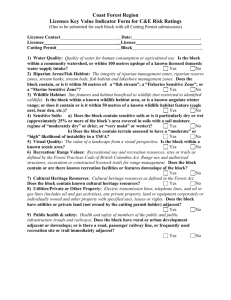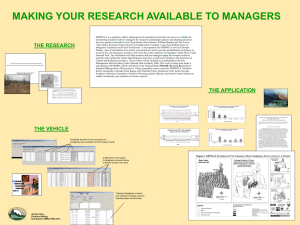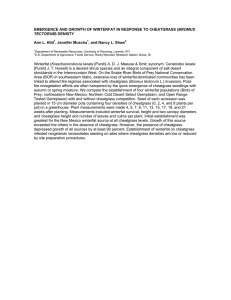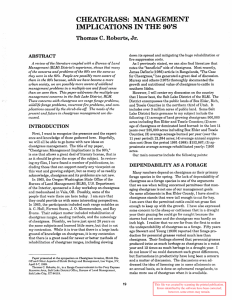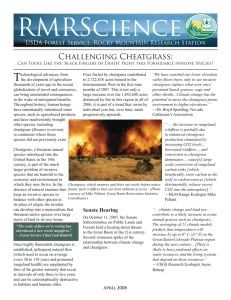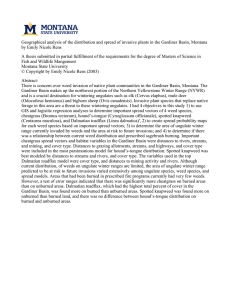WANAKET WILDLIFE AREA
advertisement
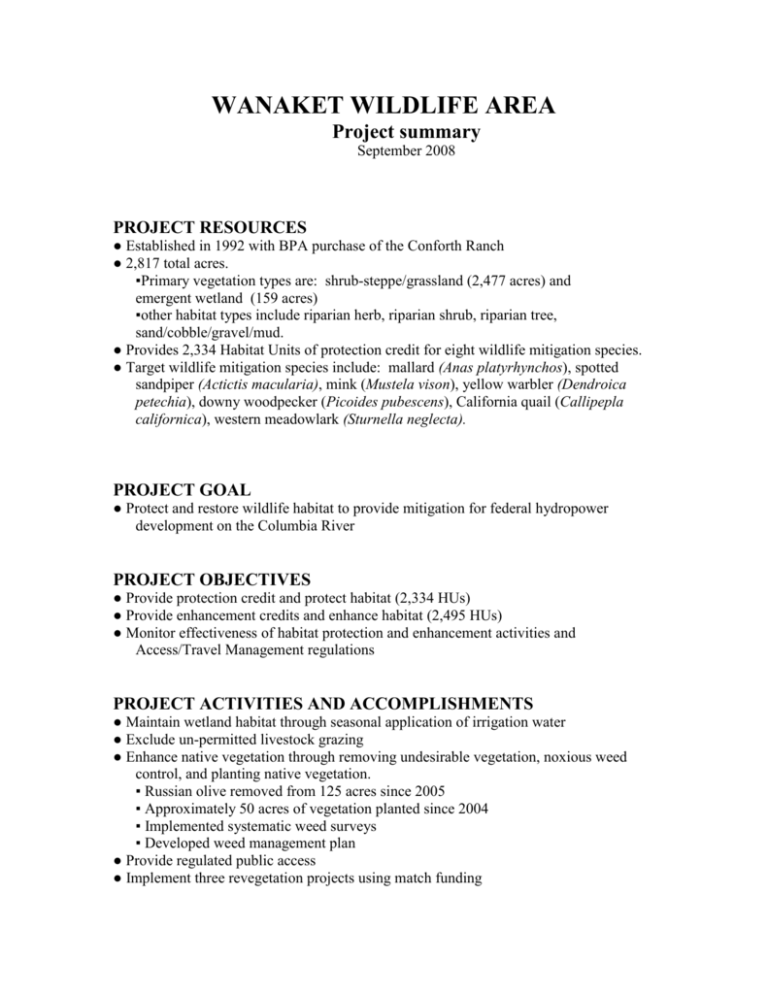
WANAKET WILDLIFE AREA Project summary September 2008 PROJECT RESOURCES ● Established in 1992 with BPA purchase of the Conforth Ranch ● 2,817 total acres. ▪Primary vegetation types are: shrub-steppe/grassland (2,477 acres) and emergent wetland (159 acres) ▪other habitat types include riparian herb, riparian shrub, riparian tree, sand/cobble/gravel/mud. ● Provides 2,334 Habitat Units of protection credit for eight wildlife mitigation species. ● Target wildlife mitigation species include: mallard (Anas platyrhynchos), spotted sandpiper (Actictis macularia), mink (Mustela vison), yellow warbler (Dendroica petechia), downy woodpecker (Picoides pubescens), California quail (Callipepla californica), western meadowlark (Sturnella neglecta). PROJECT GOAL ● Protect and restore wildlife habitat to provide mitigation for federal hydropower development on the Columbia River PROJECT OBJECTIVES ● Provide protection credit and protect habitat (2,334 HUs) ● Provide enhancement credits and enhance habitat (2,495 HUs) ● Monitor effectiveness of habitat protection and enhancement activities and Access/Travel Management regulations PROJECT ACTIVITIES AND ACCOMPLISHMENTS ● Maintain wetland habitat through seasonal application of irrigation water ● Exclude un-permitted livestock grazing ● Enhance native vegetation through removing undesirable vegetation, noxious weed control, and planting native vegetation. ▪ Russian olive removed from 125 acres since 2005 ▪ Approximately 50 acres of vegetation planted since 2004 ▪ Implemented systematic weed surveys ▪ Developed weed management plan ● Provide regulated public access ● Implement three revegetation projects using match funding MONITORING AND EVALUATION Baseline HEP Assessment Follow-up HEP Assessment (2005) Long-term trend monitoring Waterfowl production surveys Weed Monitoring Conducted by Rasmussen et al. 1991 Conducted by Regional HEP Team in 2005. 22 Permanent transects were established. 9 1/10-acre plots were established in 2000 and re-visited in 2005. Permanent transects were established on the plots in 2005. 2 pair counts and 3 brood counts conducted annually. GPS-based survey data stored in long-term database. Data include information on weed location, species, patch size and distribution, treatments, and follow-up data. ANNUAL (3 YEAR AVERAGE) PROJECT BUDGET Prepare environmental compliance documents Noxious Weed Inventory Control Noxious Weeds and Competing and Unwanted Vegetation Plant Herbaceous Vegetation Maintain Functionality of Irrigation Facilities Assist Vector Control District in Reducing Vector Production Provide Regulated Public Access Remove Modern Trash Resulting from Illegal Dumping Prevent Unregulated Human and Livestock Trespass General Administrative Duties Annual Report Periodic Status Reports for BPA Conduct Monitoring and Evaluation TOTAL $6,789 $8,142 $35,535 $14,848 $57,719 $14,011 $29,981 $9,882 $13,402 $17,809 $4,919 $3,241 $9,699 $225,977 Vegetation Treatment Projects Three projects designed to treat cheatgrass were developed in 2007 and 2008, using match funding. Different methods will be used on in project, allowing for comparison of methods. The projects are described below. 1) Use heavy, early season livestock grazing, followed by herbicide application, for three years to reduce cheatgrass competition. Reseed with native grass seed following third year of treatment. Treatment unit is 105 acres 2) Use fall application of herbicide to reduce cheatgrass competition. Then seed with native grass seed shortly after herbicide treatment. Treatment unit is 50 acres 3) In early spring, spot-spray cheatgrass in 12-18 inch circles. Mark each circle with a pin flag, and GPS the flag location. Repeat the spot-spray application on each circle in fall. Plant plugs of native grasses and forbs in winter. Spot-spray cheatgrass within in circle in spring, if needed, being sure to protect seedling from spray. FY 2007-2009 ISRP/NPCC Comments on Wanaket wildlife Area Proposal: The proposal is clearly written and complete. It describes work elements associated with continued operations and maintenance of the Wanaket Wildlife area and clearly identifies the relationship of the project to the Umatilla/Willow Subbasin plan. Primary habitat types are wetland and shrub-steppe/grassland. The benefits to focal species are clearly identified, and justification for the methods is very good. More information, however, concerning the impact of management on nonfocal species would be beneficial. The proposal includes provisions for monitoring and evaluation that apply to the multiple objectives of the project, but the project would be improved by more efforts to share lessons learned and experiences with the region, especially similar projects. This work is related to other projects, but more evidence of collaboration would have been helpful if included. . H:\WORK\WAC\2008_1007\NPCC-WANAKETprojSept2008.doc



